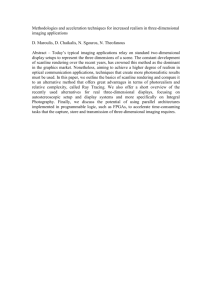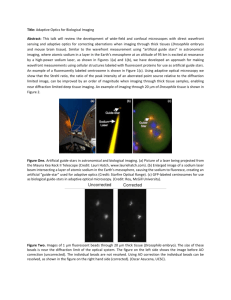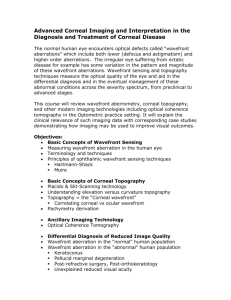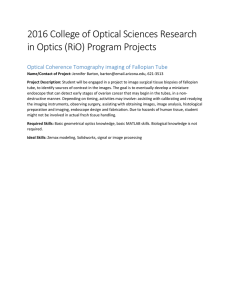Shaping volumetric light distribution through turbid media
advertisement
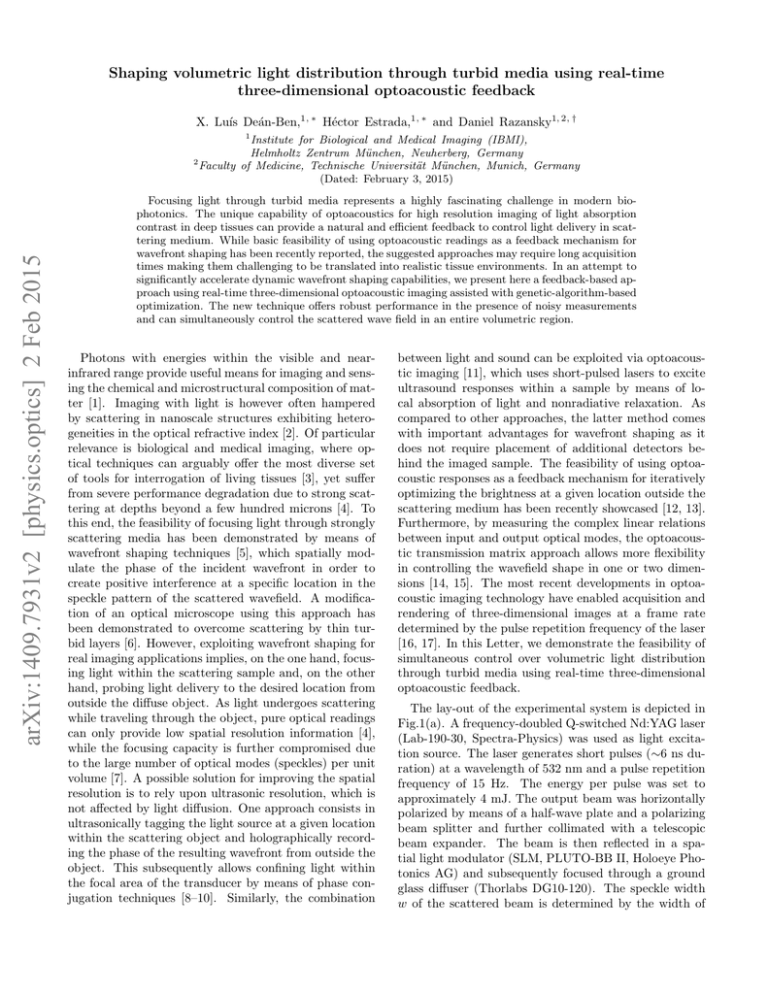
Shaping volumetric light distribution through turbid media using real-time
three-dimensional optoacoustic feedback
X. Luı́s Deán-Ben,1, ∗ Héctor Estrada,1, ∗ and Daniel Razansky1, 2, †
1
arXiv:1409.7931v2 [physics.optics] 2 Feb 2015
Institute for Biological and Medical Imaging (IBMI),
Helmholtz Zentrum München, Neuherberg, Germany
2
Faculty of Medicine, Technische Universität München, Munich, Germany
(Dated: February 3, 2015)
Focusing light through turbid media represents a highly fascinating challenge in modern biophotonics. The unique capability of optoacoustics for high resolution imaging of light absorption
contrast in deep tissues can provide a natural and efficient feedback to control light delivery in scattering medium. While basic feasibility of using optoacoustic readings as a feedback mechanism for
wavefront shaping has been recently reported, the suggested approaches may require long acquisition
times making them challenging to be translated into realistic tissue environments. In an attempt to
significantly accelerate dynamic wavefront shaping capabilities, we present here a feedback-based approach using real-time three-dimensional optoacoustic imaging assisted with genetic-algorithm-based
optimization. The new technique offers robust performance in the presence of noisy measurements
and can simultaneously control the scattered wave field in an entire volumetric region.
Photons with energies within the visible and nearinfrared range provide useful means for imaging and sensing the chemical and microstructural composition of matter [1]. Imaging with light is however often hampered
by scattering in nanoscale structures exhibiting heterogeneities in the optical refractive index [2]. Of particular
relevance is biological and medical imaging, where optical techniques can arguably offer the most diverse set
of tools for interrogation of living tissues [3], yet suffer
from severe performance degradation due to strong scattering at depths beyond a few hundred microns [4]. To
this end, the feasibility of focusing light through strongly
scattering media has been demonstrated by means of
wavefront shaping techniques [5], which spatially modulate the phase of the incident wavefront in order to
create positive interference at a specific location in the
speckle pattern of the scattered wavefield. A modification of an optical microscope using this approach has
been demonstrated to overcome scattering by thin turbid layers [6]. However, exploiting wavefront shaping for
real imaging applications implies, on the one hand, focusing light within the scattering sample and, on the other
hand, probing light delivery to the desired location from
outside the diffuse object. As light undergoes scattering
while traveling through the object, pure optical readings
can only provide low spatial resolution information [4],
while the focusing capacity is further compromised due
to the large number of optical modes (speckles) per unit
volume [7]. A possible solution for improving the spatial
resolution is to rely upon ultrasonic resolution, which is
not affected by light diffusion. One approach consists in
ultrasonically tagging the light source at a given location
within the scattering object and holographically recording the phase of the resulting wavefront from outside the
object. This subsequently allows confining light within
the focal area of the transducer by means of phase conjugation techniques [8–10]. Similarly, the combination
between light and sound can be exploited via optoacoustic imaging [11], which uses short-pulsed lasers to excite
ultrasound responses within a sample by means of local absorption of light and nonradiative relaxation. As
compared to other approaches, the latter method comes
with important advantages for wavefront shaping as it
does not require placement of additional detectors behind the imaged sample. The feasibility of using optoacoustic responses as a feedback mechanism for iteratively
optimizing the brightness at a given location outside the
scattering medium has been recently showcased [12, 13].
Furthermore, by measuring the complex linear relations
between input and output optical modes, the optoacoustic transmission matrix approach allows more flexibility
in controlling the wavefield shape in one or two dimensions [14, 15]. The most recent developments in optoacoustic imaging technology have enabled acquisition and
rendering of three-dimensional images at a frame rate
determined by the pulse repetition frequency of the laser
[16, 17]. In this Letter, we demonstrate the feasibility of
simultaneous control over volumetric light distribution
through turbid media using real-time three-dimensional
optoacoustic feedback.
The lay-out of the experimental system is depicted in
Fig.1(a). A frequency-doubled Q-switched Nd:YAG laser
(Lab-190-30, Spectra-Physics) was used as light excitation source. The laser generates short pulses (∼6 ns duration) at a wavelength of 532 nm and a pulse repetition
frequency of 15 Hz. The energy per pulse was set to
approximately 4 mJ. The output beam was horizontally
polarized by means of a half-wave plate and a polarizing
beam splitter and further collimated with a telescopic
beam expander. The beam is then reflected in a spatial light modulator (SLM, PLUTO-BB II, Holoeye Photonics AG) and subsequently focused through a ground
glass diffuser (Thorlabs DG10-120). The speckle width
w of the scattered beam is determined by the width of
2
PBS
-f1
SLM
λ/2
1
y (mm)
Laser
Particles
(b)
6
f2
f3
Scattering
layer
0
x
y
z
Multichannel
DAQ
Spherical ultrasound
array
0
1
Speckle correlation
PC
Optimisation
algorithm
x (mm)
5
0
(c)
0.5
0
-200
0
x (µm)
1 cm3 at a faster speed than the time lapse between two
laser pulses [21], i.e. rendering three-dimensional optoacoustic images in real time. Specifically, the value of the
optoacoustic image OA(x) at a point x is calculated as
X
OA(x) =
sp,i (ti ),
(2)
200
FIG. 1. (a) Schematic of the experimental setup depicting
the illumination arrangement, the imaged sample consisting
of random distribution of absorbing microparticles, and the
three-dimensional optoacoustic feedback system. (b) Image
of the speckle pattern at the sample location, as captured by
a CCD camera. (c) Speckle correlation function from (b)
i
being sp,i (ti ) the processed signal collected by the i-th
transducer element. ti = di /c is the time-of-flight from
x to such transducer element, where di is the propagation distance and c is the speed of sound in the medium.
The reconstructed three-dimensional optoacoustic image
is then used to provide feedback for optimizing the wavefront shape on a per-pulse basis.
A
y
z
x
4 mm
x
A
the illuminated area at the diffuser D as w = λz/D [18]
being λ the laser wavelength and z the distance from the
diffuser. The speckle pattern at a distance of approximately 35mm as imaged in a CCD sensor (IDS Imaging Development Systems GmbH, UI-2240SE-M-GL) is
displayed in Fig.1(b). The importance of the dimensions of the speckle is two-fold. On the one hand, the
speckle width corresponds approximately to the width of
the smallest achievable focus [19] and hence determines
the maximum fluence that can be delivered at this spot.
On the other hand, each speckle grain represents an optical mode, and the intensity enhancement η that can be
achieved by shaping the incident wavefront is given by
[7]
η=
NSLM
,
2Nmodes
(1)
where NSLM is the number of controlled degrees of freedom (pixels in the SLM) and Nmodes is the number of optical modes contained within the volume that can be resolved in the wavefront shaping optimization procedure.
In our case, the feedback mechanism for the optimization is provided with a three-dimensional optoacoustic
imaging system consisting of a spherical matrix array
of 256 piezoelectric elements covering a solid angle of
90◦ , as described in detail elsewhere [20]. Each element
has a central frequency of 4 MHz and -6 dB bandwidth
of 100%, thus providing nearly isotropic optoacoustic
resolution of approximately 200 µm around the center
of the spherical tomographic acquisition geometry. A
graphics processing unit (GPU) implementation of backprojection reconstruction allows reconstructing the optical absorption distribution in a volume of approximately
OA signal intensity (a.u)
(a)
1
0
8
6
4
2
00
500
1000
1500
Number of iterations
2000
2500
FIG. 2. The time course of the wavefront shaping optimization procedure. The evolution of the cost function for all iterations is shown, along with the maximum intensity projection
views of 3D optoacoustic reconstructions at 4 representative
iterations of the genetic optimization algorithm. The leftmost
image corresponds to a constant phase value in the SLM pixels. The particle onto which the light is focused is labeled A
(see Media 1).
In order to showcase the capability of wavefront shaping with this approach, 15 mm diameter clear agar phantom was used containing sparsely distributed 200 µmdiameter absorbing black paramagnetic polyethylene microsphres (Cospheric BKPMS 180210). The centre of
the phantom was positioned at an approximate distance
of 35 mm from the diffuser, corresponding to a speckle
grain size of 90 µm (Fig.1(c)), i.e. in the range of the
spatial resolution of the ultrasound array. The threedimensional maximum intensity projections (MIP) views
of the optoacoustic reconstructions of the phantom are
shown in Fig. 2.
In order to focus light on a given sphere (e.g. labeled A
in the leftmost image in Fig.2), one may consider as cost
function CF1 the maximum of the optoacoustic image
OA(r) in a volume of interest VOIA around the sphere,
i.e.,
CF1 = max {OA(VOIA )} .
(3)
3
The value of the cost function CF1 was then iteratively
maximized by means of a genetic algorithm. As previously shown [22], this particular type of algorithms is
more robust to noise in comparison to other optimization
techniques, such as the optoacoustic transmission matrix
approach [14]. The SLM pixels were grouped to form
a matrix array of 20×20 elements and the acquired optoacoustic signals were averaged 5 times to minimize the
influence of the per-pulse energy oscillations. The time
course of the optimization procedure is displayed in Fig.
2, where also evolution of the cost function for all iterations is shown. A three-dimensional rotational view of
the optoacoustic reconstructions during the entire optimization procedure is provided in a movie available in the
online version of the journal (see Media 1). Considering
elongated speckles having a width of 90 µm, each microsphere would approximately contain 5 speckle grains (optical modes), which corresponds to theoretically achievable light intensity enhancement of approximately 40.
Factors that may influence the maximum achievable enhancement include speckle decorrelation during the experiment, noise, laser energy oscillations, additional light
scattering by the agar medium, and SLM imperfections
[14]. In addition, the enhancement can be affected by the
initial speckle distribution at the target location.
Wavefront shaping with three-dimensional feedback
can be obviously exploited for more sophisticated control of the wavefield, e.g. by enhancing light intensity
at several points at the same time, as demonstrated in
the subsequent experiment with the same phantom. In
this case, the objective was to simultaneously focus the
light onto the spheres labeled B and C (Fig. 3(a)), representing the three-dimensional view of the phantom for a
constant value of the phase in the SLM pixels. Two volumes of interest VOIB and VOIC around these spheres
were considered with two alternative cost functions CF1
and CF2 defined as
CF2 = max{OA(VOIB )} + max{OA(VOIC )}
(4)
and
max {OA(VOIB )} + max {OA(VOIC )}
|max {OA(VOIB )} − max {OA(VOIC )}| + k
(5)
where k = max {OA(r)}|t=0 . The resulting images after 2500 iterations obtained with CF2 and CF3 are displayed in Figs. 3(b) and 3(c), respectively, along with
the evolution of the cost function during the optimization procedure. A three-dimensional rotational view of
the optoacoustic reconstructions during the optimization
procedure is provided in a movie available in the online
version of the journal for CF2 (see Media 2) and CF3
(see Media 3). At least 4 fold increase in the optoacoustic signal intensity from the two spheres is observed for
both cost functions, whereas the same signal amplitude
from the spheres is further achieved when performing the
CF3 =
optimization with CF3 . This experiment illustrates the
capability to simultaneously deliver a controlled amount
of energy to specific locations in the volume by properly
defining the cost function.
(a)
(b)
B
(c)
x
y z
C
4 mm
0
1
OA signal intensity (a.u.)
3.5
4
0.5
0
Iterations
2500
0.5
0
Iterations
2500
FIG. 3. Three dimensional views of the first iteration (a)
and the last iterations obtained with the cost functions CF2
(b) and CF3 (c) as defined in the text. The values of both
cost functions for each iteration are displayed in (b) and (c)
respectively. The particles for which light is intended to be
focused are labelled as B and C. A movie version of (b) and
(c) can be found in Media 2 and 3 respectively.
The results indicate the basic feasibility of controlling a
scattered wavefield with optoacoustic resolution in an entire three-dimensional region. In general, as compared to
pure optical approaches, optoacoustics can provide much
faster feedback mechanism as our technique is based on
simultaneous acquisition of information from an entire
volume. More importantly, when imaging several millimeters to centimeters into turbid tissues, optoacoustic
imaging can provide an order of magnitude improvement
in the spatial resolution performance over optical imaging techniques based on diffuse light [4]. This also implies lower number of optical modes enclosed within the
resolution-limited voxel and correspondingly higher intensity enhancement with optoacoustic feedback. Yet
a number of significant challenges are to be considered
before the ultimate goal of light intensity enhancement
within highly scattering tissues, in particular living biological tissues, is achieved. The speckle grain size inside
a scattering object is expected to progressively decrease
to a value in the order of λ/2. This would inevitably
increase the number of optical modes that are simultaneously captured within the resolution-limited voxel of the
optoacoustic probe. To overcome this, the number of degrees of freedom in the spatial light modulator must be
then increased accordingly for attaining significant signal enhancement. An alternative solution to reduce the
number of optical modes contained in the imaged voxel
could be sought by including absorbers with smaller dimensions in the region where light needs to be focused or
improving instead the spatial resolution of the optoacoustic feedback by scaling up the detected ultrasonic spectrum. An additional limitation is the coherence of the
laser beam used for the wavefront shaping, which condi-
4
tions the effective depth within the scattering sample for
which the interference can be produced. When considering imaging in living tissues, the light focusing capacity
is further challenged by motion and consequent speckle
decorrelation during the optimization procedure. Fast
optimization in the millisecond range is thereby required
for successful wavefront shaping. Although this capacity was not achieved yet with the current configuration
that uses laser pulse repetition and SLM refresh rates in
the order of tens of Hz, we believe that the overall threedimensional feedback approach introduced in this work
paves the way to successful application of fast wavefront
shaping techniques.
X.L.D.B. would like to acknowledge the organizers
and participants of the summer school ”Waves and Disorder 2014 - Ecole thématique du CNRS, 1-12 July
2014, Cargese, Corsica, France” for disinterestedly sharing their deep knowledge into the subject. Valuable help
from Ali Ozbek is also acknowledged. This project was
supported in part by the European Research Council
through the grant agreement ERC-2010-StG-260991.
∗
These authors contributed equally to the work
Corresponding author: dr@tum.de
[1] Y. Band, Light and Matter: Electromagnetism, Optics,
Spectroscopy and Lasers, Light and Matter (John Wiley
& Sons, 2006).
[2] A. P. Mosk, A. Lagendijk, G. Lerosey, and M. Fink, Nat
Photon 6, 283 (2012).
[3] R. Weissleder and M. J. Pittet, Nature 452, 580 (2008).
†
[4] V. Ntziachristos, Nat Meth 7, 603 (2010).
[5] I. M. Vellekoop and A. P. Mosk, Opt. Lett. 32, 2309
(2007).
[6] I. M. Vellekoop and C. M. Aegerter, Opt. Lett. 35, 1245
(2010).
[7] S. M. Popoff, G. Lerosey, M. Fink, A. C. Boccara, and
S. Gigan, New Journal of Physics 13, 123021 (2011).
[8] X. Xu, H. Liu, and L. V. Wang, Nat Photon 5, 154
(2011).
[9] K. Si, R. Fiolka, and M. Cui, Nat Photon 6, 657 (2012).
[10] B. Judkewitz, Y. M. Wang, R. Horstmeyer, A. Mathy,
and C. Yang, Nat Photon 7, 300 (2013).
[11] L. V. Wang and S. Hu, Science 335, 1458 (2012).
[12] F. Kong, R. H. Silverman, L. Liu, P. V. Chitnis, K. K.
Lee, and Y. C. Chen, Opt. Lett. 36, 2053 (2011).
[13] A. M. Caravaca-Aguirre, D. B. Conkey, J. D. Dove, H. Ju,
T. W. Murray, and R. Piestun, Opt. Express 21, 26671
(2013).
[14] T. Chaigne, O. Katz, A. Boccara, M. Fink, E. Bossy,
and S. Gigan, Nat Photon 8, 58 (2014).
[15] T. Chaigne, J. Gateau, O. Katz, E. Bossy, and S. Gigan,
Opt. Lett. 39, 2664 (2014).
[16] X. Luis Dean-Ben and D. Razansky, Light Sci Appl 3,
e137 (2014).
[17] X. L. Deán-Ben, E. Bay, and D. Razansky, Sci. Rep. 4,
(2014).
[18] J. C. Dainty, Laser Speckle and Related Phenomena, 2nd
ed., edited by J. C. Dainty (Springer Verlag, Heidelberg,
1984).
[19] I. M. Vellekoop, A. Lagendijk, and A. P. Mosk, Nat
Photon 4, 320 (2010).
[20] X. L. Deán-Ben and D. Razansky, Opt. Express 21, 28062
(2013).
[21] X. Dean-Ben, A. Ozbek, and D. Razansky, Medical
Imaging, IEEE Transactions on 32, 2050 (2013).
[22] D. B. Conkey, A. N. Brown, A. M. Caravaca-Aguirre,
and R. Piestun, Opt. Express 20, 4840 (2012).
